Please Take Note: This is a review of the game’s final prototype. The art, game bits, and the rules discussed are all subject to change. The game is being reviewed on the components and the rules provided with the understanding that “what you see is not what you might get” when the game is published. If you like what you read and want to learn more, we encourage you to visit the game’s official web page or visit the game’s Kickstarter campaign. Now that we have all that disclaimer junk out of the way, on with the review!

The Basics:
- For ages 8 and up
- For 2 to 4 players
- Approximately 60 minutes to complete
Geek Skills:
- Counting & Math
- Logical & Critical Decision Making
- Reading
- Color Matching
- Strategy & Tactics
- Hand/Resource Management
Learning Curve:
- Child – Easy
- Adult – Easy
Theme & Narrative:
- Revisit the Battle of Little Bighorn in this thematic Rummy style game
Endorsements:
- Gamer Geek approved!
- Parent Geek approved!
- Child Geek approved!
Overview
The Battle of Little Bighorn, which took place on June 25th and June 26th 1876, between the forces of the 7th Cavalry Regiment of the United States Army and the combined forces of Lakota, Northern Cheyenne and Arapaho tribes, has been studied extensively by historians. An overwhelming victory for the Native Americans, led by war leaders Crazy Horse and Chief Gall, and inspired by the visions of Sitting Bull, continues to live on through stories and scholarly debate to this day.
Little Bighorn Rummy, designed by John Longstreet and to be published by Ft. Fairfield Games, will reportedly be comprised of 102 playing cards that depict the Native Americans and the soldiers of the 7th Cavalry Regiment of the United States Army that engaged in battle in 1876. As this is a review of a prepublished game, we will not comment on the game component quality. However, the artist for the game, Matt Hulgan, has done an outstanding job of adding old photos and illustrations from the Native American who survived the battle to really bringing the theme of the game to life on the cards. Not included with the game, but necessary to play, is a pen or pencil and a pad of paper to keep track of players’ scores.
Of Chiefs and Officers
If you are familiar with the classic Rummy style games, you know that all it takes is a standard deck of 52 playing cards. The game itself is fairly strategic and requires the player to do a lot of card management in an attempt to play runs and sets. But the game has no theme or narrative that is common in most card games today. To suggest that Rummy style games are old is a gross understatement, as the game has been around in one form or another as early as the 8th century in China and is believed to be the basis of another very old game, Mah-Jong.
The game has been refined, retuned, and rethemed through the centuries. Little Bighorn Rummy is simply the newest variant on the game, and it will most certainly not be the last. But to the best of my knowledge, this is the first Rummy style game that uses a historic battle in the United States as its backdrop. And what a battle it was. As many as 300 Native Americans (as estimate, as the true number of Native American casualties was never determined) and 262 soldiers died. The battle was bloody, violent, and still lives on in the psyche of the United States through songs, paintings, and historic debates. Today, the blood spilt has long since soaked into the ground and nothing but grass grows where so many lost their lives. If you ever get a chance to visit the Little Bighorn Battlefield National Monument, do so. Scattered about the land are little markers where the lives of men, women, and children ended, and there are many markers in th sea of grass.
As this is a game based on the battle, it stands to reason the cards in the game represent the soldiers and Native Americans that played a part in it. The different cards and any noted special abilities are summarized here.
Lt. Col. George A. Custer: This card represents the commanding officer of the 7th Cavalry Regiment of the United States Army. This card penalizes the player by 20 points if Custer does not escape the battle with the help of his Officer Staff.

Company Cards: These cards, representing a total of 6 Companies (in 6 different colors, 7 cards per company), and make up the bulk of Custer’s forces.
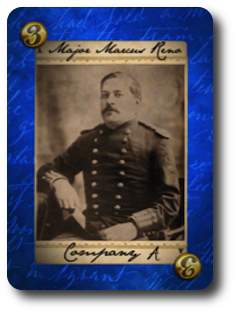
Staff Cards: These cards represent the Officer Staff that surrounds Custard (7 cards in total). They can be played for points and used to help Custer escape.
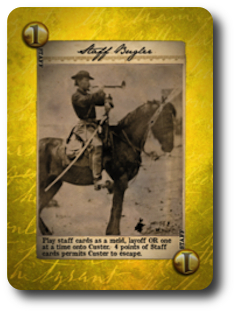
U.S. Army Scouts: These cards (6 in total) can be played as wild cards which helps player complete sets of cards.
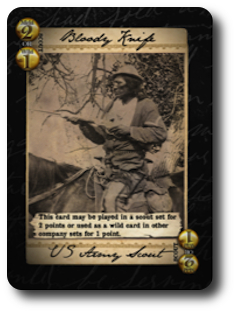
The Chiefs: These cards represent the Native American Chiefs (7 cards in total), including Chief Sitting Bull, a Hunkpapa Lakota Sioux holy man who had a vision that the land would return to his people, and Chief Crazy Horse, who fought for his people’s way of life.
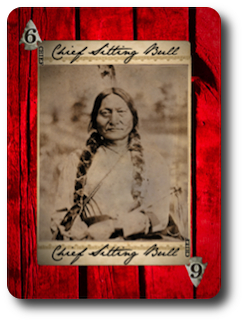
Sitting Bull’s Sundance Vision: This card, when paired with Chief Sitting Bull, stops Custer from escaping (thus forcing the player who has it on the table to take the 20 point penalty).
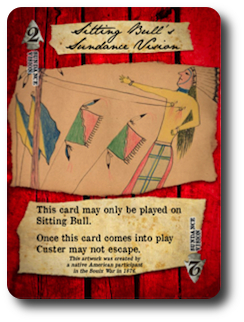
Chief Coup Sticks: These cards (6 in total), when paired with the Chief cards, allow the player to steal 3 points worth of cards from an opponent and claim them as their own.

Braves: These cards (18 in total) represent the Native American Braves who were in the encampment when Custer’s forces attacked.
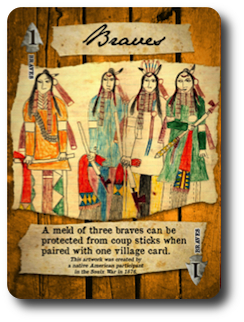
Villages: These cards (6 in total) can be paired with Brave cards to protect the owning player from having points stolen from them.
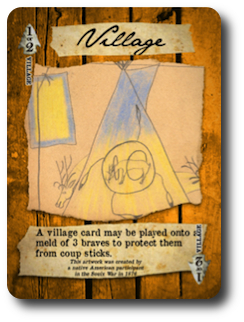
Support Cards: These are special cards (8 in total) that give the player a one time special bonus during their turn.
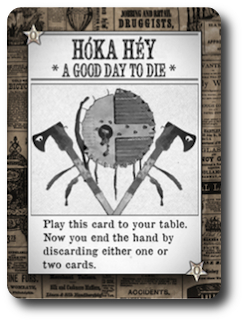
Bonus 5 Point Card: This card is awarded to a player at the end of the game and has no impact during game play other than final scoring.
Game Set Up
To set up the game, find and remove the Bonus 5 Point card and set it aside.
Second, shuffle the deck of cards and then deal out to each player their initial hand. The number of cards in a player’s initial hand is dependent on the number of players (12 cards for a 2-player game, 11 cards for a 3-player game, and 10 cards for a 4-player game). If any player is dealt the Lt. Col. George A. Custer card, it is revealed immediately, played in front of the player, and a new card is drawn to bring their hand to the same size as all the other players.
Third, set the deck of cards, face-down, in the middle of the playing area.
Fourth, the top card is taken from the draw deck and placed, face-up, next to the deck to start the discard pile. If the Lt. Col. George A. Custer card is revealed, place the card back in the deck, shuffle, and then reveal a new card to start the discard pile.
That’s it for game set up. Determine who will go first and begin!
A Battle on the Banks of a River
The game is played out in a series of hands. At the end of each hand, the scores of all the players are recorded and a new hand is dealt unless the game has been won. During a hand, players will take turns (in turn order sequence). Each player’s turn is comprised of 3 phases. These 3 phases are summarized here.
Draw Phase
During this phase, the player must draw 1 card from the top of the draw deck or take the top card from the discard pile.
Action Phase
During this phase, the player plays “melds” to the table space directly in front of them. A “meld” is three or more cards of the same color (referred to as “categories” in the rules). The only cards that can be played in this manner are Company, Staff, Scout, Braves, and Villages. Players can also play single cards to the table space directly in front of them on previously played melds or play off their opponents’ melds.
Additionally, special sets of cards and pairs can be put together during the game for extra points. For example, Custer is worth -20 points, but can “escape” (and not reduce the player’s points at all) if a number of Staff cards are played to it that have a combined score total of 4 or more, Coup Sticks can be played to Chief cards to steal cards from an opponent, and 3 Braves cards can be matched to one Village card to protect the Braves from being stolen, just to name a few.
The player can play as many cards as they like to the table, but only 1 Support card can be played per player’s turn.
Discard Phase
During this phase, the player must take one of the cards in their hand and place it in the discard pile.
A Battle Won, But Not the War
The hand can end one of two possible ways.
- During the discard phase, a player discards the last card in their hand to the discard pile
- During the draw phase, the last card is drawn from the draw deck. The player will complete their turn as normal (following through all 3 phases).
When the hand ends, the scoring beings. Players now count up all the points on the cards they have in front of them on the table. Any cards left in the player’s hand do not count as negative points. The only card that counts as negative points is the Lt. Col. George A. Custer card if it hasn’t escaped. Additionally, the 5 Point Bonus card goes to the player who went out (ended the round with a discard).
Once all the points are scored, they are recorded, and a new hand beings. The game ends when a player has scored enough points to win the game (150 for a 2-player game, 125 for a 3-player game, and 100 points for a 4-player game).
To learn more about Little Bighorn Rummy, visit the game’s official web page or visit the game’s Kickstarter campaign.
Prediction
Little Bighorn Rummy is not a wargame, despite its theme being based on the Battle of Little Bighorn. It can best be thought of as a variation of the classic Rummy style card games with some very interesting game mechanisms in play. If any player is familiar with any Rummy style game, they’ll have no problem picking up Little Bighorn Rummy and playing. But even if a player is not, the cards that grant special scoring and additional actions have a very short but highly descriptive bit of text on them to help remind the player what the card does and how it can be played. This is WONDERFULLY useful as it would hurt the game play if players had to keep looking up what special combinations were and how cards were used.
Because Little Bighorn Rummy is not a wargame and no violence is depicted or even implied, the game should be exceedingly family friendly. The game’s theme should be interesting to our Child Geeks, Parent Geeks, and even our Gamer Geeks. If we have any United States historian in our ranks, I bet they’ll be doubly excited.
I predict Little Bighorn Rummy will be very well received by the Child Geeks and the Parent Geeks. I really like what I see based on the game rules, the cards, and the game play descriptions. If the game plays anything like how it is described, the Gamer Geeks should enjoy it, too. Much more than just your standard Rummy game, Little Bighorn Rummy has some very interesting card plays and combos.
Teaching the game took us about 10 minutes. Not because the game is difficult (because it really isn’t), but because we wanted to make sure our players saw all the cards, some of the more interesting melds, sets, pairs, and how important it was to skunk another player with Custer with a Chief Sitting Bull and his Vision card combo. We also wanted to make sure that our players understood that the game was not won by rushing through a hand. For the more crafty gamer, keeping track of the long game could help them make some smart choices on when to ditch cards and when to keep them to hurt their opponents’ chances of winning. The only questions we had were about some of the Scouts and the Support cards. After we answered those, we were all set and ready to play! As I shuffled the deck of cards and dealt them around the table, I asked my oldest Child Geek his thoughts on the game so far.
“I know all about this battle. It was a sad one. The game looks great, though. Let’s play!” ~ Liam (age 8)
I feel it is necessary to again make sure it is clearly understood that Little Bighorn Rummy is not a wargame, nor does the game take any stance on who was right or who was wrong. The battle is just so much window dressing and helps tie the cards to the game play and nothing more. Let’s shuffle these cards and play a few hands to see if Little Bighorn Rummy scores BIG points with our players or very LITTLE. See what I did there?
Final Word
Much to my delight, the Child Geeks not only did very well playing the game, but played it likes little Bosses. The key to victory in Little Bighorn Rummy is hand management. Once your cards are on the table, everyone knows exactly how many points you have and where you stand. But if you keep melds in your hand, you can keep your opponents guessing. That’s what we saw with the older Child Geeks and it pleased us all. After their first game, they started to hold back more and more cards until they were playing massive melds and killer combos on a single turn. Reading is a must for this game, so our younger Child Geeks were not able to play by themselves. When matched with a Parent Geek or an older Child Geek, the younger Child Geeks demonstrated they understood how the game was played, but not to a point where we felt they could play them game by themselves. But for those Child Geeks who did play the game, they loved it. Little Bighorn Rummy was enthusiastically approved by the Child Geeks between shouts of “Lets play it again!”
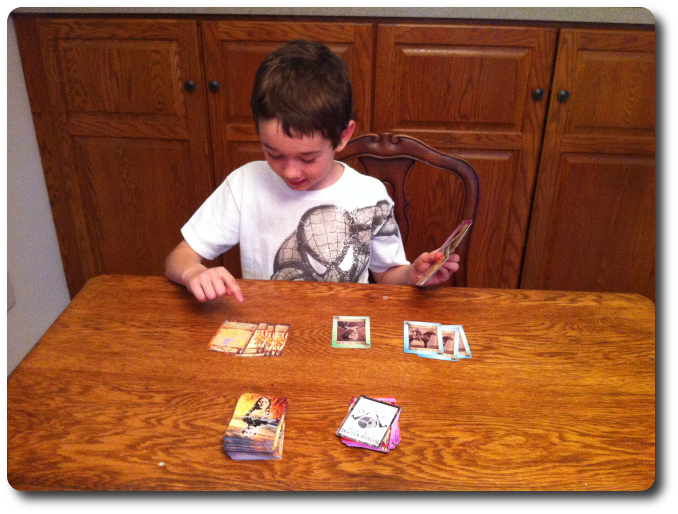
My little geek counts his points during a particularly successful hand of cards
The Parent Geeks also really enjoyed Little Bighorn Rummy. The game is very casual and can be played in a noisy room full of screaming Child Geeks without issue. The game is also very small, easy to learn, and easy to play. The non-gamers also had a great time with the game, and the more traditional card players said this was one of the better Rummy style games they had played. According to one Parent Geek, “This game has great art, a great feel, and a great flow. It’s easy to pick up and play and kept me smiling from the first card to the last!” This sentiment was shared by the majority of our Parent Geeks awarding Little Bighorn Rummy their approval.
When I told the Gamer Geeks what we would be playing, they either were happy to play it or approached the game with hesitation. For some of the Gamer Geeks and me, dark parlors, old ladies, and lots of cats come to mind when Rummy is mentioned. Rummy is not a “modern” game, after all, and most of the Gamer Geeks I played the game with learned the classic Rummy style standard card games from their Grandparents. Needless to say, once the game was out on the table, dealt, and in play, all of those preconceived (and inaccurate) notions melted away. The Gamer Geeks had a great time with Little Bighorn Rummy and found it wonderfully engaging. This is most certainly a “lighter game” when we put it up against the normal games the Gamer Geek elitists like to play, but there’s surprisingly a lot going on with the cards that had all the Gamer Geeks watching their hands and their opponents very closely. After the games were through, all the Gamer Geeks thought it was either one of the better Rummy style games they had played or the best. They all agreed to approve it and looked forward to playing it again.
I must admit that I am surprised by my own reaction to this game. I have played Rummy style games before, thought the experience was “OK”, but didn’t really think much about the game after playing it. No more than I think about what I ate yesterday for lunch. And yet, after playing Little Bighorn Rummy, I found my mind wandering back to review card plays, specific opponent plays, and regret some obvious poor choices. I have a hard time putting my finger on why, but Little Bighorn Rummy really tickled my imagination and critical thinking. The card combos are a lot of fun to attempt and there is an equal amount of “attacking” and “defending” in the game that allows the players to interact with each other. I can’t even begin to tell you how much fun it was to race to find Sitting Bull’s Vision card in hopes of sticking my opponent with Custer!
Often times, the best games are those that keep you thinking and remembering them long after you’ve stopped playing them. Little Bighorn Rummy is one of those games. The game designer has perfectly mixed critical thinking, strategy, and tactics using simple and light game play. While the objective is always the same, how one gets there is always different. Best of all, tactics and strategies will shift during the game. When a player suddenly draws Custer midway through a hand, they scramble and must refocus and so do the other players. The careful card plays suddenly turn more aggressive and visceral as everyone tries to ditch cards as fast as possible or find that perfect combo for the win. This type of game play was unexpected and greatly pleased me. I highly recommend Little Bighorn Rummy to Child, Parent, and Gamer Geeks who are looking for an engaging Rummy style card game to play at their table.
This game was given to Father Geek as a review copy. Father Geek was not paid, bribed, wined, dined, or threatened in vain hopes of influencing this review. Such is the statuesque and legendary integrity of Father Geek.




FatherGeek:
I wanted to thank you for your nice review of my game. You preview was very heartwarming and made my wife and I smile with the comments you made. I received your email about your friends wondering if the game was still on Kickstarter. YES IT IS! In anyone i s still interested you can go to the campaign “http://www.kickstarter.com/projects/929799192/little-bighorn-rummy-0” and pledge $18 to pick up one copy of the game